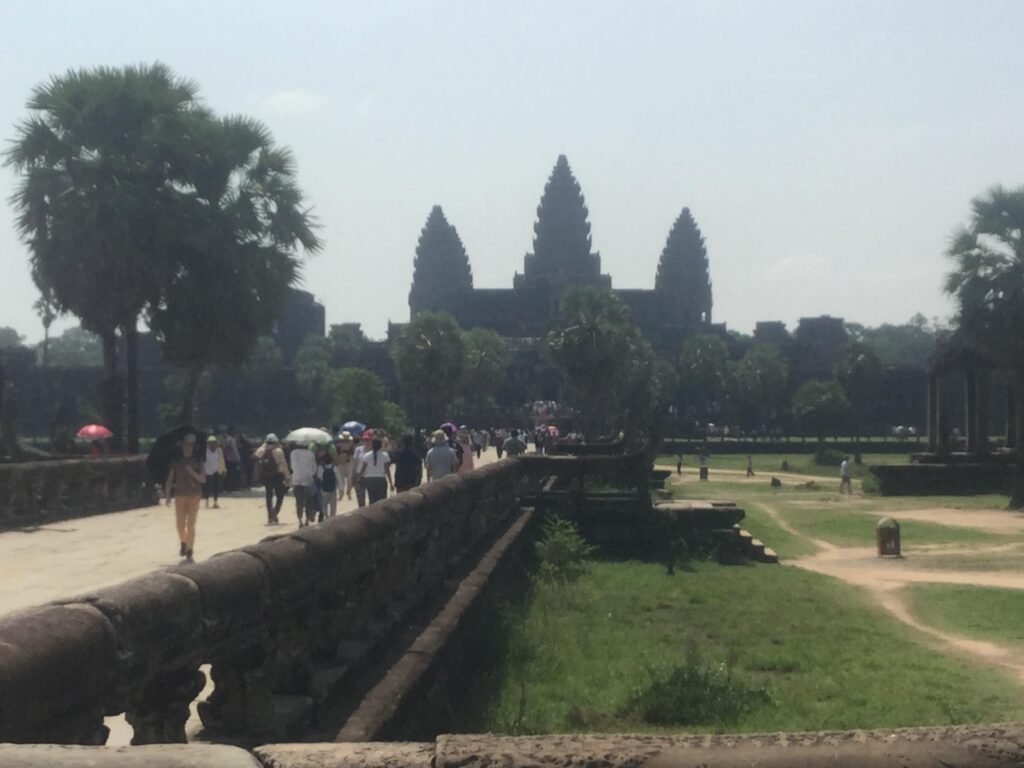Today, I got up early as I wanted to have breakfast before my 4-hour bus ride. However, to my surprise, the gates at the front of the hostel were chained shut. I did not even want to think what would have happened if there were a fire. Anyway, as the proprietors were in an apartment of the building, I went and knocked on the door telling them I had to check out immediately. They seemed almost offended. I arrived at the bus stop just in time for the bus to pull up. For the life of me, I can not understand why buses for such journeys do not have bathrooms. It did have wifi, however, which was surprising in its own right.
My bus mates were a hodgepodge of people, although one group was a bunch of teenagers. They appeared to be members of a swim team on their way to compete. A few hours and a few work tasks later, we arrived at the border. This would prove to be an interesting process.
All of us had to deboard the bus and have our passports inspected by military personnel . We were then shuffled through a corridor to find our bus waiting on the other side. We got back on and we were then taken to a Duty-Free shop about 20 minutes in the No Man’s Land between countries. It was there I was greeted by an old friend I had not seen in years.
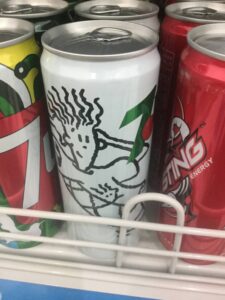 When I was younger, there was a cartoon character named Fido Dido. Since I could not draw that well, I was impressed by his simplicity. He even had an equally simplistic canine companion. There was a Saturday morning cartoon show and since it was so popular, he was used for an advertisement for 7-Up. After almost fading completely from my memory, here in this remote part of the world, his visage (and my childhood) was staring back at me from a can, his wavy hair just the same as I remembered.
When I was younger, there was a cartoon character named Fido Dido. Since I could not draw that well, I was impressed by his simplicity. He even had an equally simplistic canine companion. There was a Saturday morning cartoon show and since it was so popular, he was used for an advertisement for 7-Up. After almost fading completely from my memory, here in this remote part of the world, his visage (and my childhood) was staring back at me from a can, his wavy hair just the same as I remembered.
We were at the Duty-Free shop for about 2 hours as our bus had document issues and we needed to wait for a new one to arrive. We were then taken to the next document checkpoint. This took much longer than anticipated as we needed yet again to get off the new bus, shuffle through another checkpoint, pay an entry fee of $30, go down a corridor, then get on the waiting bus.
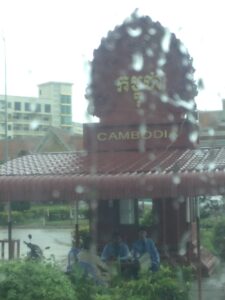
When we were finally able to begin on our way again, there was a light rain. This was to be my introduction to Cambodia. Immediately across the border, there were dozens of casinos and casino hotels. I guess communists liking to gamble with other people’s money is popular across the world.
As Eastern Cambodia passed the bus windows, I could tell that this was a much poorer place than even Vietnam. After another few hours, I arrived at the bus stop in Phnom Penh, the capital city and imperial seat of Cambodia.
There were a bunch of pushy tuk tuk drivers, the ubiquitous covered motorcycle rickshaws, at the bus stop that I had to ignore as my hostel was not that far away. The weather had cleared, and it was balmy as I walked to the hostel. After about a 20-minute journey, I arrived at my destination. It was facing the expansive riverwalk, and I immediately fell in love.

The staff greeted me warmly and showed me to my bunk. I dropped my bags and headed to the rooftop at their suggestion as it was two for one happy hour. I had my Cambodia Beers for one American dollar and looked out over the Mekong River from my perch. It was warm and beautiful.
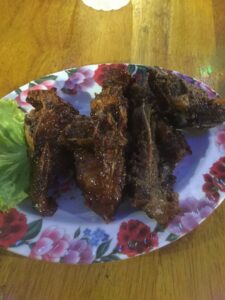 I was hungry after my journey, so as night fell, I headed back to a restaurant I noticed walking to my hostel. I sat down, pointed to the menu, and was brought out a medium-sized plate of delicious short ribs. The waitress came back with my bill. It was $2.
I was hungry after my journey, so as night fell, I headed back to a restaurant I noticed walking to my hostel. I sat down, pointed to the menu, and was brought out a medium-sized plate of delicious short ribs. The waitress came back with my bill. It was $2.
I then headed to the night market. It was a giant Bazar that opens when the sun goes down. There were all sorts of souvenirs, crafts, and food, but there was something else too.
Due to the foot traffic, especially of tourists, this was a popular spot for seeking alms. As I rounded a corner, an unexpected figure laid upon the ground that initially frightened me. There was a man that was about 25 years old; his skeletal, pocked marked face housed only one working eye. He had no legs upon which he could stand. He had no forearms and could not even hold his alms cup which laid in front of him. I surmised what happened to him and many other people in this country. As probably a child, he was playing in a nearby field when he uncovered something peeking out from the Earth. He got closer to it, wondering what this strange object was. He got down on his hands and knees and began brushing away the dirt. And that is when the land mine exploded. My fight or flight took over and I quickly walked past his wailing. The emotional shock took a while to wear off as I hurriedly got back to the hostel. I had never seen a person like that in the flesh that was still alive, let alone begging for my help. After I recollected myself, I felt incredibly guilty. This guilt continues to haunt me.
The next day, I got up and had a delicious breakfast at the hostel. I decided that this day I would take a tuk tuk to the main reason why I came to Cambodia and Phnom Penh specifically: Tuol Sleng.
The Khmer Rouge was a Communist force that took control of most of Cambodia from 1975-1979. In the quest for a completely agrarian form of Communism, they liquidated the cities and moved the entire population into the countryside. Anyone that was thought to be an intellectual, including the crime of just wearing glasses, or a subversive was either immediately executed, worked to death, interrogated, and/or tortured to death. They were lead by the mysterious French-educated Marxist revolutionary Politique Potentielle, or as he would infamously be known around the world as Pol Pot.
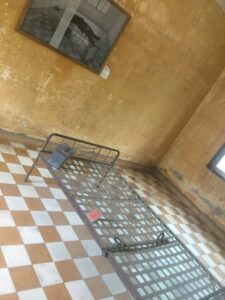 Tuol Sleng (Poisonous Tree Hill,) or Security Prison 21 was a former high school that was converted into a prison and interrogation center after the residents of Phnom Pehn were forcibly evacuated by the Khmer Rouge. I arrived at the prison, paid my entry fee, got my audio guide, took a deep breath, and passed through the gate. It would have been appropriate for the words Abandon All Hope Ye Who Enter Here to be scrawled across the doorway. Upon entering the grounds, the first exhibit was a classroom converted to torture chamber. They still had bodies in them when the invading Vietnamese and Cambodian liberation armies discovered them. Known only to God, they were buried in the courtyard. Of the 15,000 to 20,00 people that were “processed” here, only 12 survived.
Tuol Sleng (Poisonous Tree Hill,) or Security Prison 21 was a former high school that was converted into a prison and interrogation center after the residents of Phnom Pehn were forcibly evacuated by the Khmer Rouge. I arrived at the prison, paid my entry fee, got my audio guide, took a deep breath, and passed through the gate. It would have been appropriate for the words Abandon All Hope Ye Who Enter Here to be scrawled across the doorway. Upon entering the grounds, the first exhibit was a classroom converted to torture chamber. They still had bodies in them when the invading Vietnamese and Cambodian liberation armies discovered them. Known only to God, they were buried in the courtyard. Of the 15,000 to 20,00 people that were “processed” here, only 12 survived.
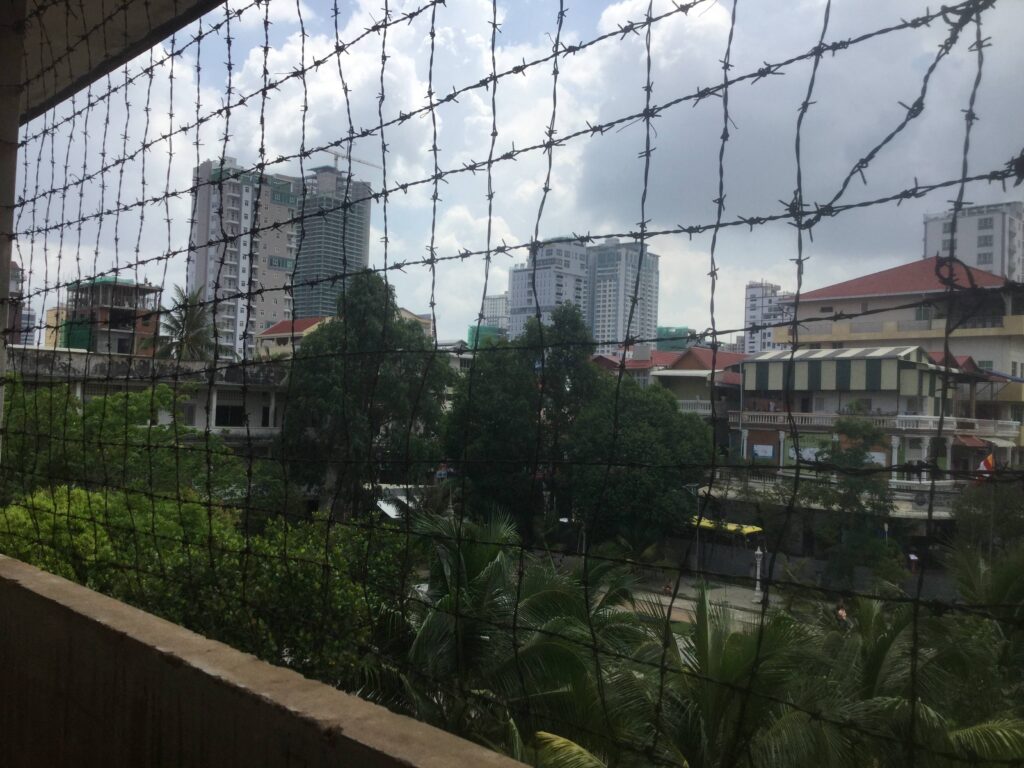
The prisoners were tortured up to three times a day, taken from their crude cells of cinderblock or brick. Some were put in stress positions until they passed out, then had their heads dunked in human waste until they revived to be strung up again. Others were waterboarded or submerged in crude tanks. The women, other than the constant threat of rape, had venomous centipedes put on them, or in them; aside from the torture of watching their children immediately killed. Still, others were caned, cut, or electrocuted.
The guards were comprised of the nearly unlimited resource of war torn countries, child soldiers. They were mostly boys and teenagers taken from villages far away. Sometimes they would get overzealous with their punishments before confessions were extracted, killing the prisoner being questioned. If it occurred too many times, they would become the ones imprisoned.
The head honcho of the prison, Kaing Guek Eav with the alias Duch, was a math instructor that was introduced to Communism and was jailed for it under the French occupation of Indochina. Just like in Hoa Loa in Hanoi, this practice only strengthened his resolve. Now in control of his own prison, his fetish was efficiency. He would devise tactics to best extract confessions and would then teach his willing young participants.
 I continued walking through the exhibits, which included thousands of photographs. When a new inmate was taken to the prison, Duch in his quest to catalog everything, used the same colonial French prisoner portrait camera set up to take them. In this room, they shared a story of a New Zealand man that was in the wrong place at the worst possible time. Kerry Hamill and some friends were sailing off the Gulf of Thailand when a storm blew them off course. They were intercepted by Khmer Rouge forces after one of the friends was killed during their arrest. Hamill was taken here, to Prison S-21, where he was interrogated for months. The fruit of these months of constant torture was that he confessed that his CIA contact was one Colonel Sanders. Satisfied with his confession, Hamil was executed by being burned alive. He was 26.
I continued walking through the exhibits, which included thousands of photographs. When a new inmate was taken to the prison, Duch in his quest to catalog everything, used the same colonial French prisoner portrait camera set up to take them. In this room, they shared a story of a New Zealand man that was in the wrong place at the worst possible time. Kerry Hamill and some friends were sailing off the Gulf of Thailand when a storm blew them off course. They were intercepted by Khmer Rouge forces after one of the friends was killed during their arrest. Hamill was taken here, to Prison S-21, where he was interrogated for months. The fruit of these months of constant torture was that he confessed that his CIA contact was one Colonel Sanders. Satisfied with his confession, Hamil was executed by being burned alive. He was 26.
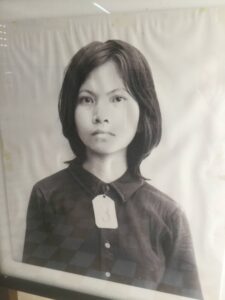 But the face of this prison was a young and beautiful woman named Hout Bophana. A brief story of her life is that she fell in love with a distant cousin that was a monk. They were to be married until a coup occurred in Cambodia. She was later raped by Cambodian soldiers loyal to the king which begot her a son. When the Khmer Rouge took power, like the entire country, she was moved to the countryside. She nearly died due to exhaustion, working in the fields and also due to the lack of proper medical care. If not for her love that returned, a new cadre for the Khmer Rouge that nursed her back to health. They shared desperate love letters, which eventually betrayed them both as they wrote in both Khmer and French. Her betrothed was executed for putting love above revolution. She was taken to Security Prison 21, endured months of torture, authoring thousands of pages of forced confessions. She was executed in 1977, also aged 26. Her pretty, yet defiant countenance crossed the threshold of space and time, challenging onlookers in reserved judgment as if asking, “What will you do with the story of my life? And death?”
But the face of this prison was a young and beautiful woman named Hout Bophana. A brief story of her life is that she fell in love with a distant cousin that was a monk. They were to be married until a coup occurred in Cambodia. She was later raped by Cambodian soldiers loyal to the king which begot her a son. When the Khmer Rouge took power, like the entire country, she was moved to the countryside. She nearly died due to exhaustion, working in the fields and also due to the lack of proper medical care. If not for her love that returned, a new cadre for the Khmer Rouge that nursed her back to health. They shared desperate love letters, which eventually betrayed them both as they wrote in both Khmer and French. Her betrothed was executed for putting love above revolution. She was taken to Security Prison 21, endured months of torture, authoring thousands of pages of forced confessions. She was executed in 1977, also aged 26. Her pretty, yet defiant countenance crossed the threshold of space and time, challenging onlookers in reserved judgment as if asking, “What will you do with the story of my life? And death?”
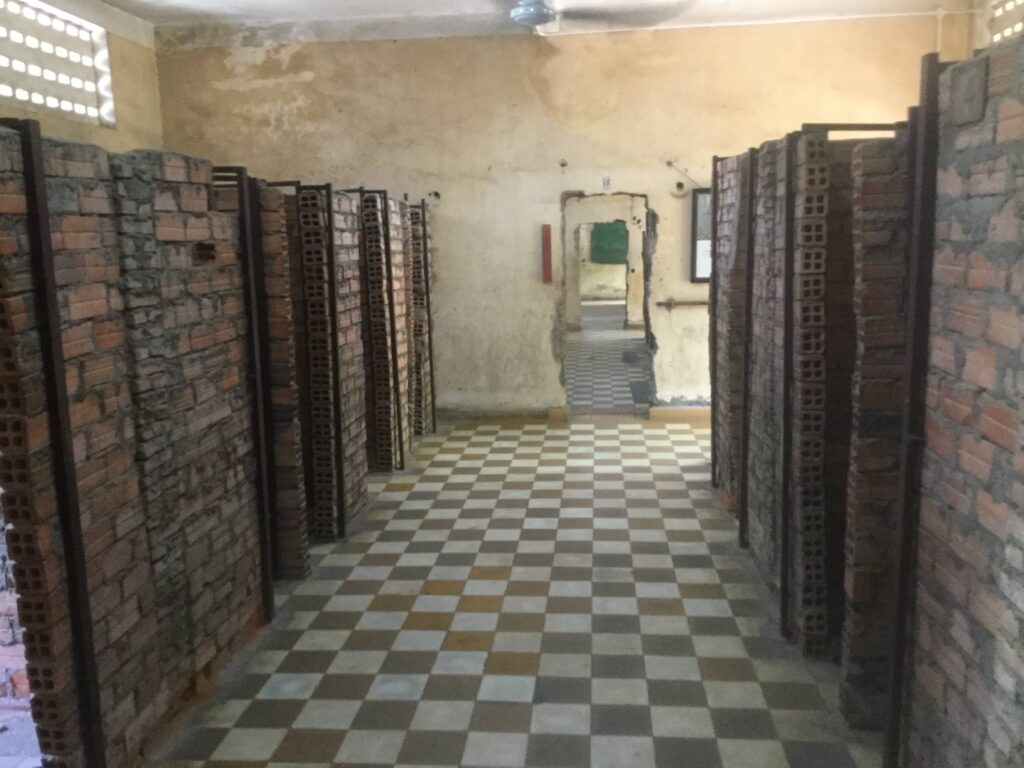
I continued through the rest of the museum. As a way to garner an income, they had a few survivors at the museum willing to talk about their experiences. But this was too much for even me. What was I going to ask? How was it being tortured? How do you feel knowing that your loved ones had a fate worse than death coming here?
I decided to walk back to the holding cells and the interrogation rooms one more time to etch them into my memory. By the exit, I took a seat and just let the emotions wash over me as I finished the audio recording. I zoned out just looking at the plants and trees that the compound contained. It was then this beautiful young woman crossed my sight, with tears in her eyes. Maybe it was just the fact that we had already seen so much that day, but I wanted to run to her, talk to her, and comfort her. She quickly walked past me and headed from the museum. I took a few minutes to gather my composure, then too left.
I took respite at a nearby coffee shop, weighing the rest of my plans for the day. I decided I was already in a certain frame of mind and wanted to continue through the bowels of human depravity and misery. I hired another Tuk Tuk to take me to the Choeung Ek.
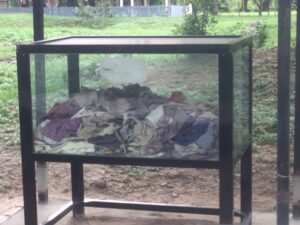 Choeung Ek was one of the biggest Killing Fields in the country. As the name suggests, this was where thousands of people that were considered enemies of the state were killed. Their bodies were then thrown into pits to cover the crime. Due to its proximity, Tuol Sleng was the main feeder for the site. About 10,000 remains have been recovered. Due to the rain and constantly shifting soil, new ones are actively being found.
Choeung Ek was one of the biggest Killing Fields in the country. As the name suggests, this was where thousands of people that were considered enemies of the state were killed. Their bodies were then thrown into pits to cover the crime. Due to its proximity, Tuol Sleng was the main feeder for the site. About 10,000 remains have been recovered. Due to the rain and constantly shifting soil, new ones are actively being found.
It was about 15 kilometers away, and the TukTuk was on the open road, dodging trucks and at one point a Lamborghini. There were children playing in giant cement piping as we drove past. Turning down a dusty road, we arrived at the entrance.This place was in the middle of nowhere and for good reason.
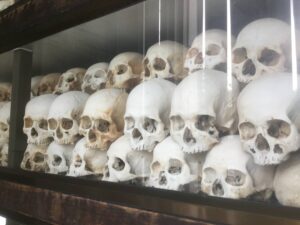 Choeung Ek used to be used as a Chinese burial ground but was then repurposed for the revolution. All of the people that were “processed” at Tuol Sleng prison were sent here as their last stop. They were told they were being moved to new housing. In the middle of the night, a truck of about 60 blindfolded people would pull up to Cheong Ek (it rose to about 300 people a day by the end,) and one by one they were killed with whatever was handy: farming implements, clubs, branches, palm fronds, but never bullets as they were too expensive.To mask the sounds of death, the Khmer Rouge hung a large amplifier from a tree playing communist anthems. Apparently, they put DDT, a now-banned pesticide, on the dead to help with the smell. The buildings, along with the records that used to be here, were destroyed and used by locals to rebuild their homes after they lost everything in this country’s Civil War. Therefore, a lot of the evidence needed to be gathered from first-hand accounts.
Choeung Ek used to be used as a Chinese burial ground but was then repurposed for the revolution. All of the people that were “processed” at Tuol Sleng prison were sent here as their last stop. They were told they were being moved to new housing. In the middle of the night, a truck of about 60 blindfolded people would pull up to Cheong Ek (it rose to about 300 people a day by the end,) and one by one they were killed with whatever was handy: farming implements, clubs, branches, palm fronds, but never bullets as they were too expensive.To mask the sounds of death, the Khmer Rouge hung a large amplifier from a tree playing communist anthems. Apparently, they put DDT, a now-banned pesticide, on the dead to help with the smell. The buildings, along with the records that used to be here, were destroyed and used by locals to rebuild their homes after they lost everything in this country’s Civil War. Therefore, a lot of the evidence needed to be gathered from first-hand accounts.
The first mass grave the audio tour took us to was one where they found 450 bodies. Then they took us on a little walking tour around a lake. Apparently, more bodies were buried in the marshes. There was a crippled man on the other side of a fence with his hand out, so I gave him some money. More bodies were buried next to our raised walkway that took us over the excavations grounds. The grim discoveries were put into plastic boxes that we could see. They included bone fragments, teeth, and strips of clothing. There was even a grave for decapitated Khmer Rouge soldiers that tried to defect to Vietnam. As their saying went, “Vietnamese head, Cambodian body.” Needless to say, I got very, very heated when I saw some asshole was wearing a Che Guevara tshirt touring the grounds.
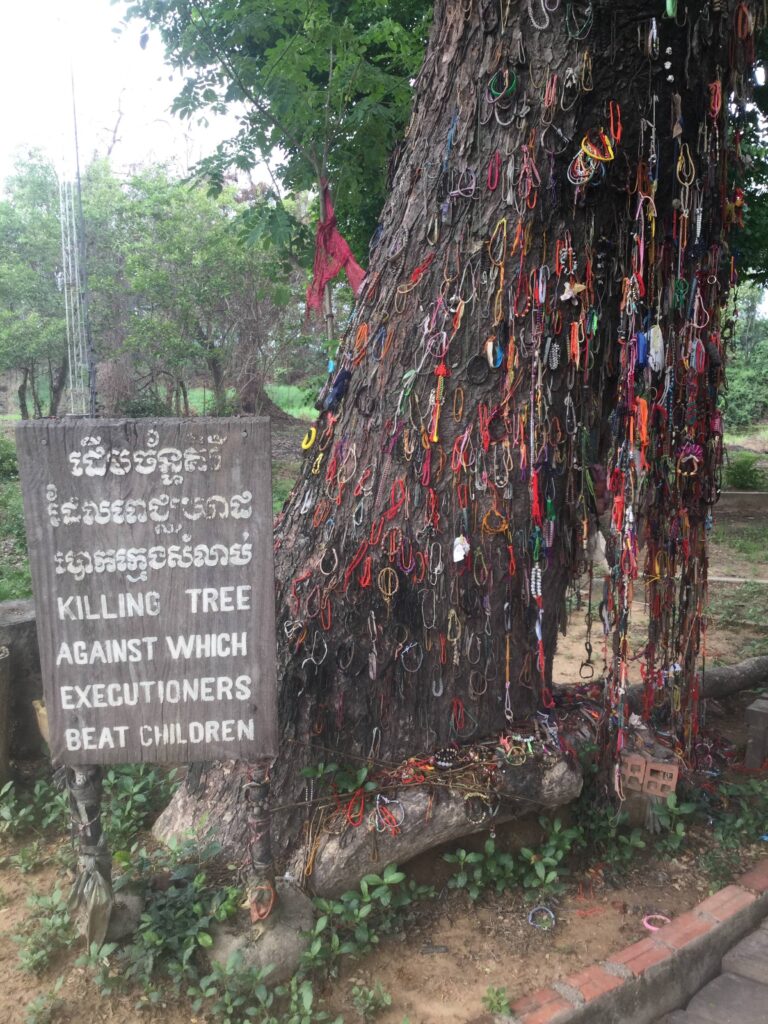
The last mass grave I passed, fitted Pol Pot’s motto, “To kill grass, you need to pull it out by the root.” It was a grave for mothers and their young children. The women were usually naked, probably raped, and the final element of their torture was to watch their children, babies mostly, swung against the Killing Tree before being killed themselves. When the site was discovered, there was bone and brain matter still in the bark. I had to take a minute, so I put my hand on the tree in a space that was not covered by ornamentation and reflected. I thought that even if I could not help those children then, I would try and help them now. I then walked to the memorial stupa, where they housed 17 stories of human skulls. They were all examined by forensics experts, cataloged by sex, age, and way they died.
I needed to go back to the Killing Tree one more time to etch it into my memory. I stared at it for a solid five minutes. People left me alone as they could see the look on my face and the purpose with which I walked. I went back to the stupa for the same reason. In a quiet corner, I said a prayer and swore I would never forget.
The warden and architect of torture, Duch was eventually brought to justice. He converted to Christianity and asked for forgiveness from those he killed as well as their families. He swore he did not know what was going on in Choeung Ek. He repealed his sentence of 34 years in jail and ended up getting life in prison. He died in 2020 at age 77. Pol Pot, the leader of the Khmer Rouge, died of a heart attack in 1998 at age 72.
After my long day, I took a TukTuk back to the city, bought some postcards for my friend and nephews, and had a beer. Needing some time to myself and something stronger, I headed to a nearby hotel’s rooftop deck and had a few cocktails as fireworks went off in the distance. Apparently, it was the King’s birthday. I texted my family to see how they were as I needed some comfort from all I had witnessed that day. I went back to my hostel’s rooftop bar as it what getting late. I looked and there was a young woman sitting by herself. As we were both alone, I walked over to her and asked if I could join her. When she looked up, by way of kismet, it was the same beautiful young woman I had seen at Tuol Sleng. We spent the rest of the night together, talking about her native Holland and the other tours she was going to do in Cambodia as well as love, heartbreak, and everything in between. It was the perfect way to end such a long and difficult day.
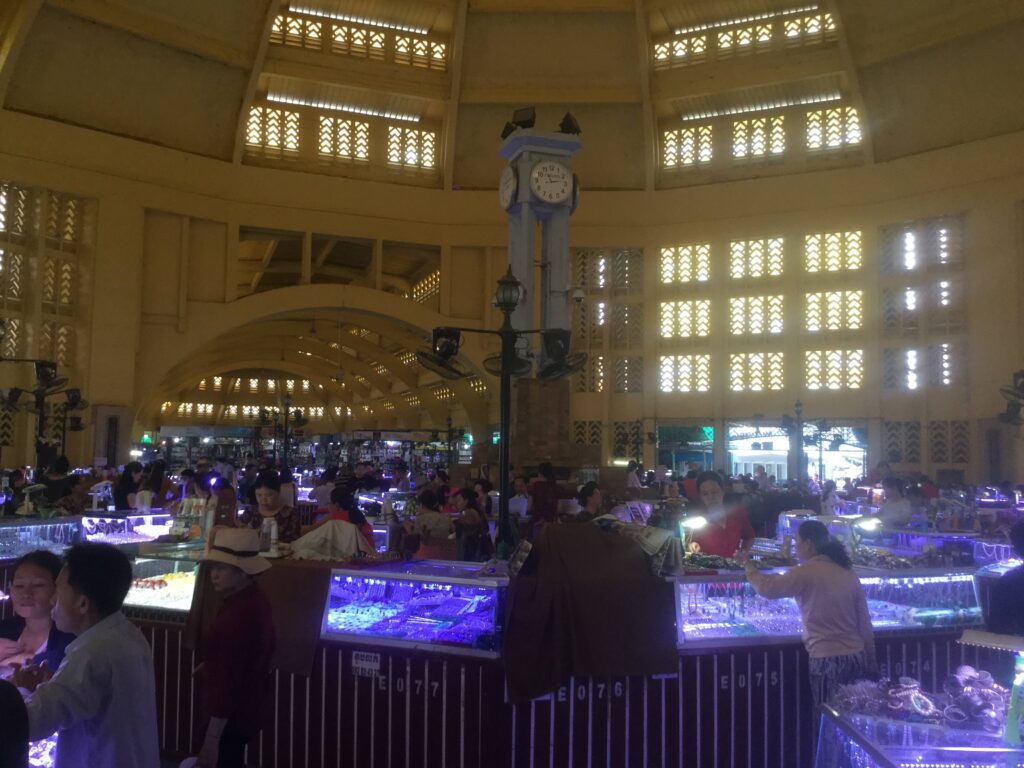
The next day, I found a post office and dropped off my postcards. I then headed to the central market as I am still looking for a money clip as my wallet was too bulky for my travel clothes. Unfortunately, all the ones I found were held together with magnets which would wreak havoc with my credit cards. I did find a bracelet that looked like some of the ornaments adorning the Killing Tree as a reminder of the promises I made.
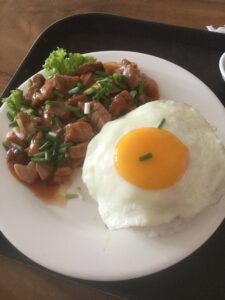 I got back to the hostel and saw that AirSerbia lived up to the promise of amending my flight from Budapest to Belgrade for free! I had lunch at the hostel, which was a wonderful little dish called Lok Lak. It was like a pork curry with rice and eggs. I then hiked over to the national museum.
I got back to the hostel and saw that AirSerbia lived up to the promise of amending my flight from Budapest to Belgrade for free! I had lunch at the hostel, which was a wonderful little dish called Lok Lak. It was like a pork curry with rice and eggs. I then hiked over to the national museum.
The entry fee was a steep $10, a daily wage for most of the people in the country if even that. There were a lot of statues of Buddha and Hindu gods from antiquity. There was even one that looked incredibly like the Venus De Milo. They also had the world’s biggest loom for kramas, the ubiquitous Cambodian scarf. However, what made the price of admission worth it was an American artifact. After the Apollo 17 mission, Richard Nixon decided that this was an achievement for all of humanity. He sent Cambodia, a country in which he was conducting a not-so-secret war, a sample of moon rock. He did this for 135 countries along with a formal letter. Not going to lie, I got a little teary when I saw an American flag next to an astronaut on the moon. I thought it was a touching gesture.
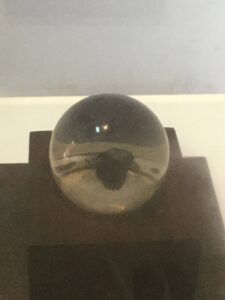
As I was leaving the museum, the staff gave me two flowers to place as an offering to the Buddha as well as some Riels, the Cambodian currency. Walking outside of the museum, there was a man sitting on the ground with books and other things to sell. He stopped me and we got to talking. He handed me a card that said that he was disabled and did not want to beg. So he was selling stuff. I ended up buying a book of printed cards of the sites of Cambodia that was beautiful. Iʼll have them framed when I return home.

I walked back to the hostel to cool off thinking this was my last day. I checked my schedule and it turned out I still had another day. I walked down to the Chroy Changvar Bridge, which crosses the Tonle Sap River, a feeder for the Mekong. It is also known as the Cambodian-Japanese Friendship Bridge as the Japanese, knowing that Cambodia was an incredibly poor country, offered aid and know-how in constructing the bridge.
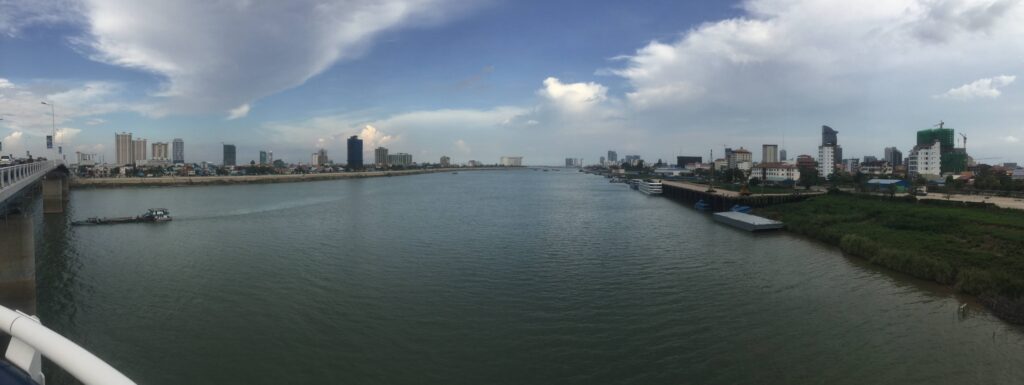
I took a few pics looking over the Tonle Sap River as it greeted the Mekong, then started walking back to the palace, dodging human shit and flattened rats. As I was walking along the crowded riverwalk towards the royal palace, an older man stopped me and started a conversation. He wanted to know where I was from, how long I have been here, and what I planned to do. He did not want anything, only to practice his English. He was very nice.
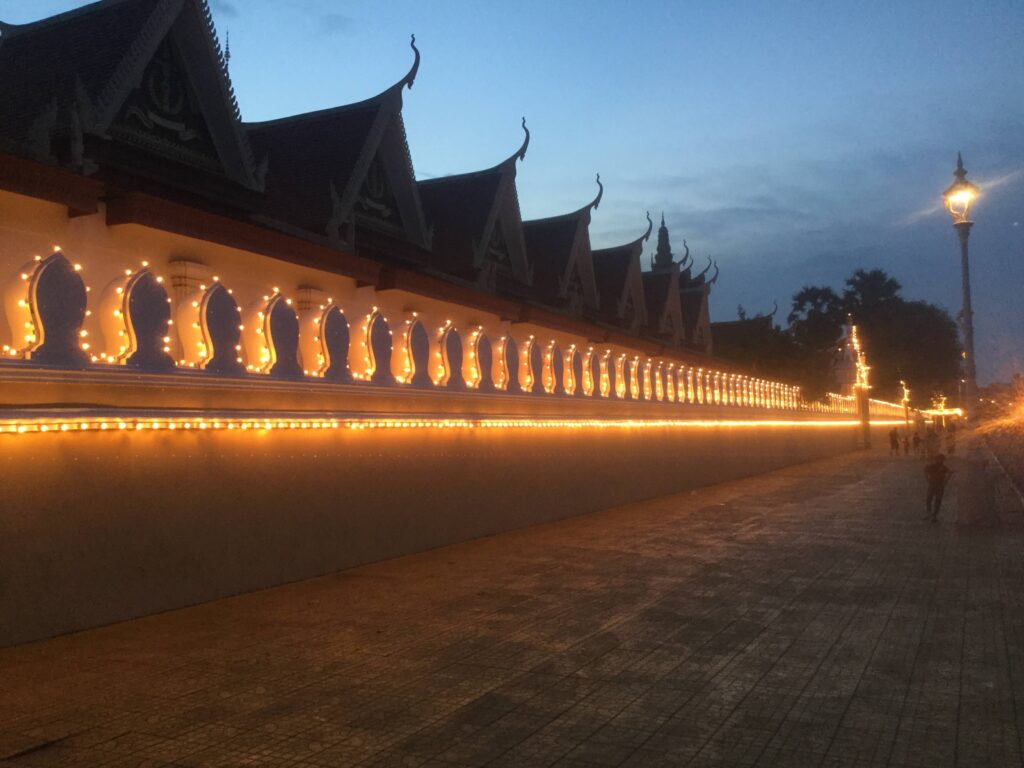
I realized that something had changed in me from my time in Vietnam. While it was obvious I was not from there, people seemed both surprised and grateful that I was there in their little corner of the world. However, I would become more acquainted with the darker side of Cambodia’s openness to travelers.
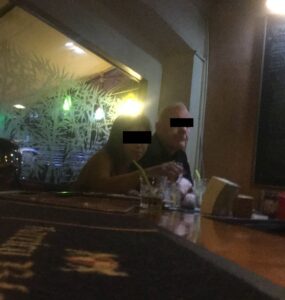 As night fell, I headed back towards my hostel. I went to the night market and had a little dinner from a stall which was delicious. I looked for the begging man from my first night, but he was not there. As my cousin just graduated high school, I found a small bar close by where I could have a beer and compose him a note to accompany his graduation gifts. While I was sitting there, I noticed something. While Cambodia is crass running joke as far as sex tourism, it was something completely different seeing it first hand. At one end of the bar, an older white man was sitting with a young Cambodian woman. I then remembered all the notices and warnings posted about sex trafficking in Phnom Penh, especially of children. I did not know what to do.
As night fell, I headed back towards my hostel. I went to the night market and had a little dinner from a stall which was delicious. I looked for the begging man from my first night, but he was not there. As my cousin just graduated high school, I found a small bar close by where I could have a beer and compose him a note to accompany his graduation gifts. While I was sitting there, I noticed something. While Cambodia is crass running joke as far as sex tourism, it was something completely different seeing it first hand. At one end of the bar, an older white man was sitting with a young Cambodian woman. I then remembered all the notices and warnings posted about sex trafficking in Phnom Penh, especially of children. I did not know what to do.
I headed back to my hostel.
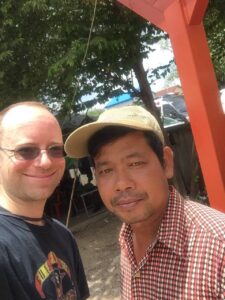 The next morning, after being greeted by a lovely thonged derriere of one of my hostel mates, I had breakfast and started my walk to the Royal Palace. Due to the intense heat, I found out all too late that the palace was closed to visitors. Dejected, I started walking back to my hostel to figure out my next plan. A voice yelled out to me. A Tuk Tuk driver speaking English asked me how I was. We started talking and he introduced himself as Thom. He said that if I wanted to, he would take me around to a few local temples. Since I had nothing else planned, I broke my cardinal rule of never getting a ride from a stranger’s solicitation. I had to stop back at the hostel first to get my fare. I gave him half of the agreed $20 fare upfront so he would not dump me by the roadside. He then took me across the Chroy Changvar Bridge. Passing some amazing woodworking stores, we arrived at the Golden Temple.
The next morning, after being greeted by a lovely thonged derriere of one of my hostel mates, I had breakfast and started my walk to the Royal Palace. Due to the intense heat, I found out all too late that the palace was closed to visitors. Dejected, I started walking back to my hostel to figure out my next plan. A voice yelled out to me. A Tuk Tuk driver speaking English asked me how I was. We started talking and he introduced himself as Thom. He said that if I wanted to, he would take me around to a few local temples. Since I had nothing else planned, I broke my cardinal rule of never getting a ride from a stranger’s solicitation. I had to stop back at the hostel first to get my fare. I gave him half of the agreed $20 fare upfront so he would not dump me by the roadside. He then took me across the Chroy Changvar Bridge. Passing some amazing woodworking stores, we arrived at the Golden Temple.
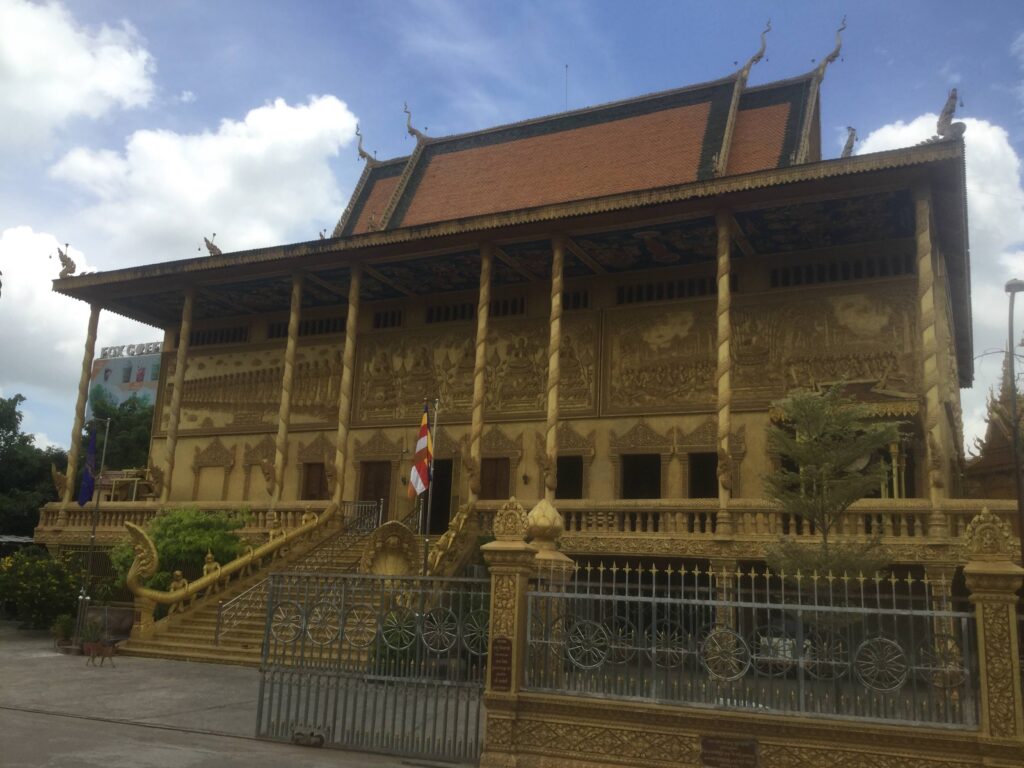
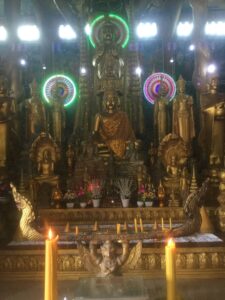 The Golden Temple was still an active Buddhist monastery. Men with orange robes and shaved heads were walking around as I hopped out of Thom’s tuk-tuk. I made my way up the golden stairs to the entrance of the temple. I took off my shoes as is the custom and entered. Within the temple were about a dozen statues of the Buddha. Behind them were enough blinking and whirring LED lights to cause an epileptic fit. I had never seen anything like it: the ancient buttressed by the modern.
The Golden Temple was still an active Buddhist monastery. Men with orange robes and shaved heads were walking around as I hopped out of Thom’s tuk-tuk. I made my way up the golden stairs to the entrance of the temple. I took off my shoes as is the custom and entered. Within the temple were about a dozen statues of the Buddha. Behind them were enough blinking and whirring LED lights to cause an epileptic fit. I had never seen anything like it: the ancient buttressed by the modern.
I climbed back into Thom’s Tuk Tuk as he took me to the Boat Temple. Phnom Penh rests along the banks of often flooding rivers. When it was bad, people could not go to temple. When it was really bad, people could not go to temple because it was washed away. So, they decided to put a temple on a boat. It would be stationary until the water rose while it was still moored. It was pretty ingenious.
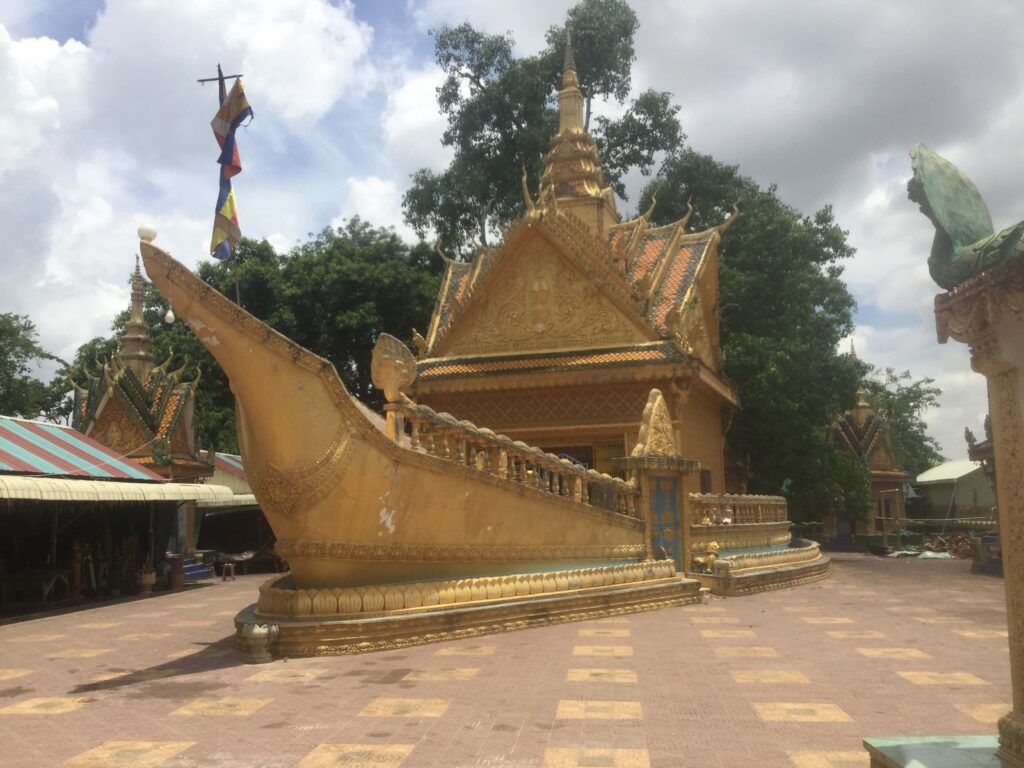
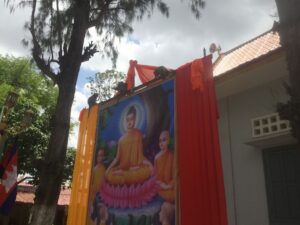 Afterward, Thom drove me out to the Monkey Temple. It was aptly named as there were monkies all over the place. However, I knew it was a popular tourist destination from what happened next. As soon as I got out of the Tuk Tuk, there was a group of young boys. One that could not have been older than four wrapped his arms around my waist greeting me. I had no idea how to feel about this. The little boy let go and I started walking around the temple. I was asked every few seconds for money. It broke my heart for a few reasons. The first being that it felt like I was betraying my promise to those murdered children at the Killing Tree. The second is that while I would have liked nothing more than to give them all money, I did not know if it would go directly to them or to a Fagin. Lastly, while the thought entered my mind of paying them for a photograph of the group, it dawned on me that that would set an awful precedent for the kids of accepting money from a tourist to take pictures. I hurriedly saw the sites of the temple then got back into my tuk-tuk where Thom was entertaining the children with a video of a rooster he was raising to fight. As we were driving away, he told me that those kids did not go to school and that begging tourists for money was their main income.
Afterward, Thom drove me out to the Monkey Temple. It was aptly named as there were monkies all over the place. However, I knew it was a popular tourist destination from what happened next. As soon as I got out of the Tuk Tuk, there was a group of young boys. One that could not have been older than four wrapped his arms around my waist greeting me. I had no idea how to feel about this. The little boy let go and I started walking around the temple. I was asked every few seconds for money. It broke my heart for a few reasons. The first being that it felt like I was betraying my promise to those murdered children at the Killing Tree. The second is that while I would have liked nothing more than to give them all money, I did not know if it would go directly to them or to a Fagin. Lastly, while the thought entered my mind of paying them for a photograph of the group, it dawned on me that that would set an awful precedent for the kids of accepting money from a tourist to take pictures. I hurriedly saw the sites of the temple then got back into my tuk-tuk where Thom was entertaining the children with a video of a rooster he was raising to fight. As we were driving away, he told me that those kids did not go to school and that begging tourists for money was their main income.
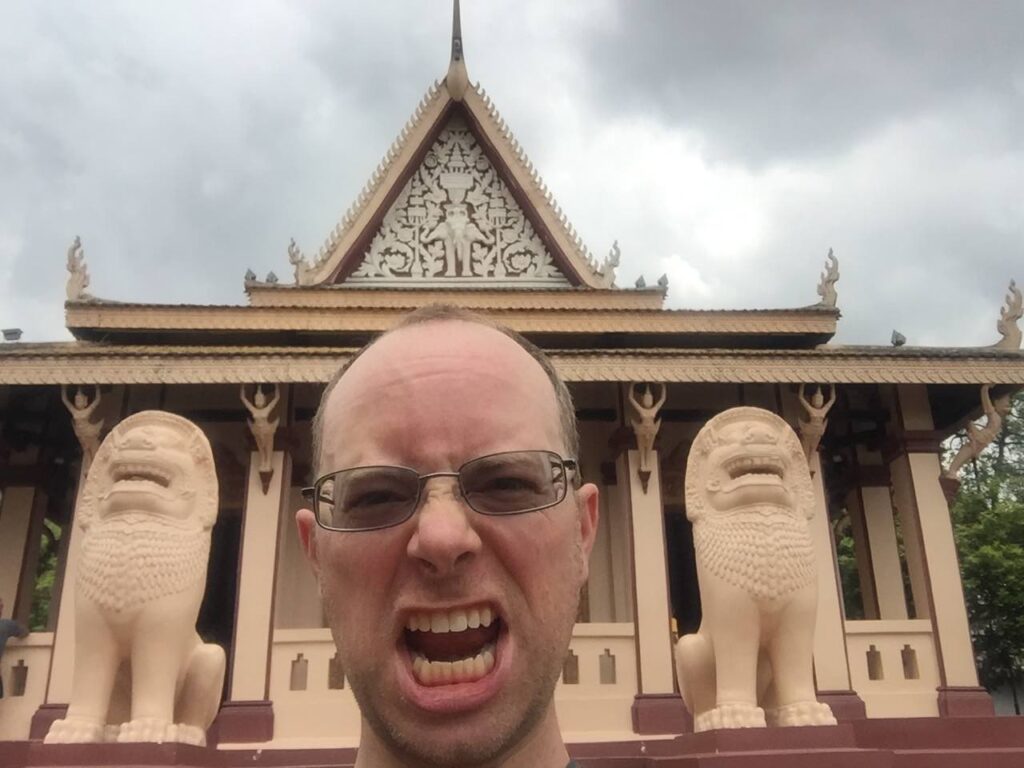
While the deal was to take me around to the temples then return me back to the Royal Palace for its opening, it still had not opened. Thom suggested the Temple on the Mount, or Wat Phnom. Before we parted company and since he was such an excellent guide, I gave him a tip equal to the entire fare. We talked a little more and I asked a few questions about the Khmer Rouge and where he thought Cambodia would be in 5-10 years. He told me that both his Aunt and Uncle were killed by them. He continued that the Khmer Rouge was crazy and wanted to destroy Cambodia. He then said that the Cambodia of today is incredibly corrupt. The Prime Minister had been in power for 35 years. He said the only way you can get rich is to either be a government official or a police officer. I then asked about the Chinese. He said they were the worst. He continued that they made deals with the government for construction and infrastructure but only for the Chinese, not for Cambodians. He did say that he liked the Japanese very much as they gave Cambodia so much for free. He told me that within the next 5-10 years, the gap between the haves and the have-nots would only increase. He looked around and saw another tuk-tuk driver was listening to our conversation. It appeared that old habit of informing on others died hard. He closed the conversation by saying with the money I gave him, he could take his hour commute back home and be with his family for a week without having to come back to the city. We shook hands, exchanged Facebook information, and parted as friends.
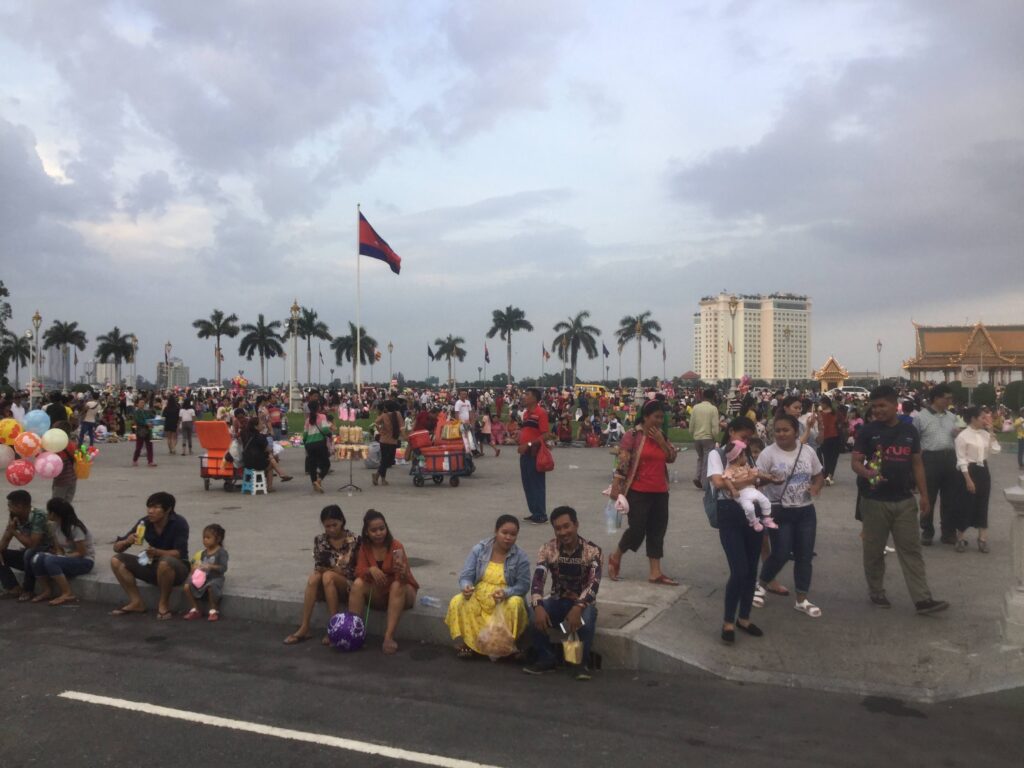
I toured around Wat Phnom then walked back to the hostel to have lunch. I ended up taking a power nap for much longer than I wanted. As it was raining, I had a passion fruit smoothie looking out as the rain cleaned the river walk. When the rain cleared, I walked around Phnom Penh for the last time until dark.



